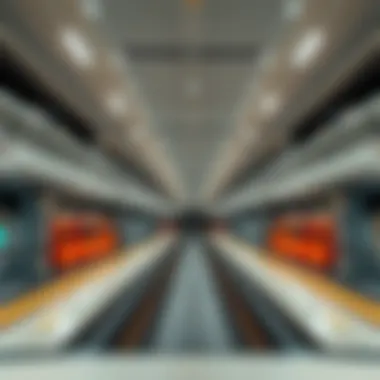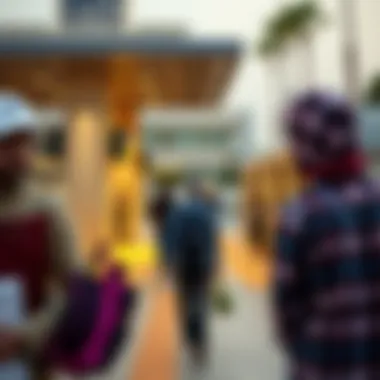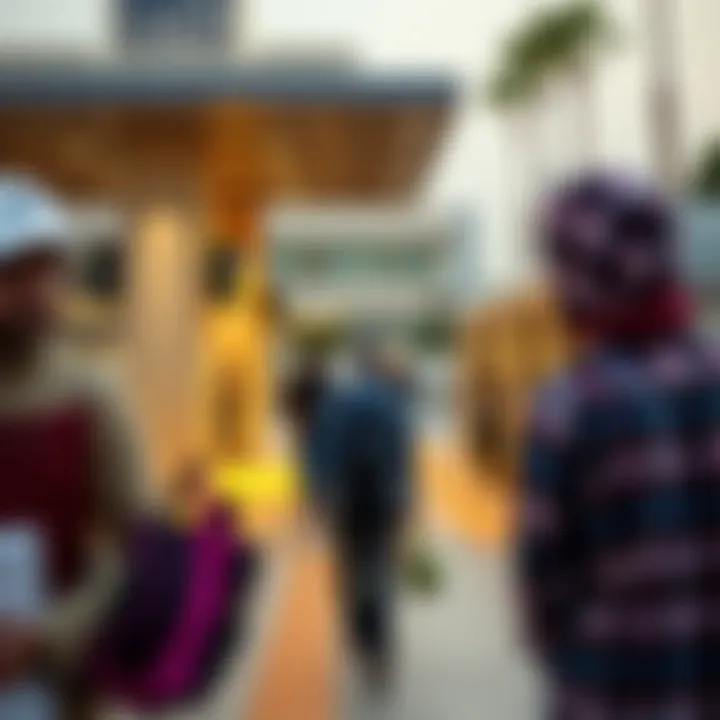Al Nahda Metro Station: Connecting Community and Transit


Intro
In the rapidly evolving urban landscape of Dubai, Al Nahda Metro Station emerges as a compelling embodiment of modern transit solutions, weaving together convenience and community. This pulsating hub does not merely function as a point of passage; it cultivates a vibrant gateway that connects diverse neighborhoods and enhances the overall quality of life for its users.
From its strategic placement to its multifaceted architecture, every aspect of Al Nahda Metro Station reflects the dynamic spirit of Dubai. Beyond tiles and trains, this station is a cornerstone for both daily commuters and potential investors, offering critical insights into the real estate market that flourishes around it. With an ever-growing population and a thirst for convenient living, the integration of such transport systems leads to meaningful dialogues about urban development and planning.
In the following sections, we'll unpack the various layers of Al Nahda Metro Station, including its architectural significance, role in the local community, and its substantial impact on real estate dynamics. We'll delve into market insights that reveal current trends and price analysis in the vicinity. Additionally, investment strategies will be discussed, highlighting the nuances of buying versus renting and potential financing options.
Prepare to explore how a transit station transcends its primary function and plays an integral role in shaping the urban fabric of Dubai.
Prolusion to Al Nahda Metro Station
Al Nahda Metro Station is more than just a point on the extensive map of Dubai's public transportation system; it represents a unique convergence of convenience and community. This station is located in a vibrant district, making it a vital transit hub for residents and visitors alike. Understanding Al Nahda's importance requires a closer look at its historical background and how it integrates with the local environment.
Historical Context
The establishment of Al Nahda Metro Station can be traced back to Dubai's rapid urban development in the early 2000s. As the city began embracing its role as a global metropolis, the need for a reliable and efficient public transport system became paramount. The inception of the Dubai Metro in 2009 marked a significant turning point. Al Nahda Station, one among several, was carefully designed not only for functionality but also reflected the city’s ambitious vision of modernization. From the initial phases of planning to its eventual opening, this station has played a significant role in shaping the transport landscape of Dubai. Its inception was influenced by strong demographic trends, notably the rising number of expatriates and residents seeking an efficient commute amid the hustle and bustle of a growing urban center.
Location and Accessibility
Conveniently nestled near the border of Dubai and Sharjah, Al Nahda Metro Station is a beacon of accessibility. It is situated at the edge of one of the city’s most bustling neighborhoods. The entrance is designed to funnel commuters seamlessly from the roads below to the trains above. The station serves as a pivotal link for numerous residential areas, local businesses, and educational institutions, illustrating its role as a critical transit point. For commuters, accessing the station is straightforward; multiple bus routes converge here, and ample parking facilities nearby add to the overall convenience.
- Strategically placed, Al Nahda Metro Station not only enhances local transit access but also promotes a greater connection to the heart of Dubai’s commercial zones. Its close proximity to major thoroughfares means that whether one is heading to work, school, or leisure activities, the station provides a reliable gateway.
Improving the community’s quality of life has undoubtedly been a priority for the planners. The relatively new pedestrian walkways and safe crossing areas around the station ensure that foot traffic is managed efficiently, allowing everyone – from families to business professionals – to navigate with ease.
"A well-integrated metro system can change the dynamics of a city, and Al Nahda Station exemplifies this change within Dubai's transport narrative."
In summary, Al Nahda Metro Station is a shining example of how effective planning and design can make life easier for residents and visitors alike. It is more than just a station; it is a vital component of Dubai’s ambition to foster an interconnected, thriving urban community.
Architectural Design and Features
The architectural design and features of Al Nahda Metro Station are not just about aesthetics; they serve a crucial role in enhancing commuter experience and reaffirming the station's standing as a vital nexus in Dubai’s transportation narrative. A well-thought-out design signifies more than just a roadmap for commuters; it embodies the spirit of connectivity and functionality that caters to a diverse pool of users. From the exterior facades to the intricate interior layouts, every aspect is curated to provide an experience that is anything but ordinary.
Exterior Design Elements
At first glance, the exterior of Al Nahda Metro Station commands attention. The design is modern and sleek, characterized by clean lines and an open feel. This is intentional, as it aims to integrate seamlessly with the towering skyscrapers nearby. The natural light that streams through expansive glass panels creates a welcoming atmosphere, encouraging foot traffic and making it feel less like a typical transit facility and more like a community space.
Moreover, the carefully chosen materials not only enhance the aesthetic appeal but also contribute to durability and maintenance ease. Shades of reflective silver and cool blues create a calming environment, a stark contrast to the bustling city that surrounds it. The landscaping around the station softens the edges of its structure, allowing it to blend into the urban environment rather than dominate it.
“Great architecture is like great art; it must invoke emotion and inspire connection.”
Interior Layout and Facilities
Once you step inside the station, the well-thought-out interior becomes apparent. The layout is spacious, ensuring that even during peak hours, congestion is minimized. Clear signage in multiple languages aids both locals and expatriates, simplifying navigation amid the hustle and bustle. The facilities within — from the clean waiting areas to ticketing kiosks — are designed for efficiency.


Notable features include ample seating areas with charging stations and concise digital displays showing updated schedules and information. There’s a convenience store present as well, ensuring that commuters can grab a quick bite or drink before they embark on their journey. Furthermore, separate zones are designated for families and individuals, recognizing diverse rider needs.
Sustainability Initiatives
Sustainability is woven into the fabric of Al Nahda Metro Station's design. The station employs energy-efficient lighting and incorporates recycling bins throughout, promoting a green ethos among its users. Furthermore, the use of water-saving technologies in restroom facilities epitomizes the commitment to conservation.
The roof is equipped with solar panels, supporting the station’s power needs while reducing reliance on non-renewable resources. The design takes advantage of natural ventilation, reducing the need for air conditioning, which further underscores its commitment to sustainability.
Each of these aspects plays a substantial role in shaping not just the user experience but also the impact on the environment. Investors and developers looking into this vicinity would do well to recognize that such sustainability efforts add intrinsic value, substantially contributing to the overall appeal of properties in the area.
For further reading about architectural advancements and sustainability in public spaces, resources from Wikipedia and Britannica can prove beneficial.
Integration with Urban Development
The Al Nahda Metro Station serves as a bedrock of urban development in Dubai. Its strategic positioning within a bustling area reflects not only its thoughtful design but also its pivotal role in shaping community dynamics and economic growth. As the rapid pace of urbanization continues, the integration of such transportation hubs with local development becomes paramount.
With enhanced connectivity, Al Nahda Metro Station significantly improves access to various districts, making it easier for residents and visitors to navigate the city. It encourages a symbiotic relationship between public transport and urban growth, allowing nearby businesses and residential areas to flourish collaboratively.
Surrounding Commercial Establishments
In the immediate vicinity of Al Nahda Metro Station, one finds a mix of retail, dining, and service establishments. Notable components include well-known shopping centers such as Al Nahda Mall, offering a variety of retail outlets and leisure options, making it a popular spot for both locals and tourists. The station’s presence has expanded commercial activity in the area, providing businesses more foot traffic while helping commuters fulfill daily needs without straying far from their routes.
Moreover, the establishment of cafes and restaurants along the station route exemplifies the adaptive nature of commerce in response to commuter patterns. For example, the likes of Starbucks and Tim Hortons see steady patronage from individuals on their morning commutes, representing how transit convenience drives the local economy.
The commercial footprint around Al Nahda is not just bustling; it's thriving.
Residential Complexes Nearby
For residents, living near the Al Nahda Metro Station presents added value. Numerous high-rise apartments and upscale condominiums like Al Nahda Towers and The Ritz cater to a mix of families, expatriates, and young professionals. Accessibility to the metro allows tenants to enjoy a car-free lifestyle while significantly reducing commute times to key business districts and leisure spots.
Furthermore, the increasing desirability of these apartments feeds directly into Dubai's evolving real estate market, initiating a steady price appreciation and elevating the area's profile.
Benefits of Nearby Residential Options:
- Convenience: Quick access to metro connections minimizes travel time.
- Lifestyle: Proximity to shopping centers and recreational facilities enhances urban living experiences.
- Community: Vibrant neighborhoods foster social interactions among diverse populations.
Public Amenities and Services
Beyond commercial and residential factors, the Al Nahda Metro Station is surrounded by essential public amenities and services that elevate the quality of life for its residents. Parks and green spaces like Al Nahda Park offer recreational areas for families and individuals seeking leisure activities outdoors.
Additionally, schools and healthcare facilities in close range ensure that residents have access to crucial services. Institutions like GEMS Modern Academy provide quality education, while clinics and pharmacies cater to health needs, adding layers of convenience that enhance community appeal.
The interconnectivity of these amenities with the Al Nahda Metro Station symbolizes the essence of urban planning that values accessibility and quality of life.
"The integration of transit hubs like Al Nahda with local amenities transforms neighborhoods into flourishing communities."
In summary, the integration of Al Nahda Metro Station with urban development reflects a blueprint for successful city planning, where transport, commerce, residence, and public services work hand in hand to create vibrant urban ecosystems.


Impact on Real Estate Market
The influence of Al Nahda Metro Station on the real estate landscape is undeniably significant, positioning it as a crucial element in Dubai's urban development. The convenience offered by the metro station not only facilitates daily commutes but also shapes the dynamics of property prices, investment prospects, and overall community growth. For investors, buyers, and developers, understanding these impacts is pivotal to making informed choices in a location imbued with potential.
Pricing Trends in Al Nahda Area
Al Nahda's proximity to the metro station has transformed it into a desirable location for both residents and property buyers alike. Pricing patterns reveal a consistent upward trajectory over recent years. Homes and apartments near the station have started to command higher prices compared to those further away. Key drivers of this trend include:
- Accessibility: Being close to Al Nahda Metro Station allows residents to easily connect with other areas in Dubai, which is often a key factor in property valuation.
- Demand: As more expatriates and locals eye Al Nahda as a place to settle down, particularly given its vibrant community life, demand invariably drives up prices.
- Amenities: The surrounding infrastructure and amenities have improved, further enhancing the area's appeal, making property investment increasingly enticing.
The average price per square meter has reached competitive levels, making the area ripe for investment. Selling units in this vicinity has resulted in substantial returns for property owners, establishing a trend set to continue.
Investment Opportunities
Given the increasing popularity of Al Nahda resulting from its metro station, various investment opportunities have emerged. Beginner and seasoned investors alike can benefit from several venture avenues:
- Residential Developments: With the uptick in demand for housing, developers are urged to consider launching new residential projects. These could range from luxury apartments to budget-friendly flats catering to diverse demographics, particularly expatriates and young professionals.
- Commercial Spaces: As the neighborhood flourishes, there is a need for commercial properties that cater to this growing population. Businesses, retail shops, and food outlets are all well-positioned to thrive near the station, given the foot traffic it generates.
- Flexible Leasing Options: For investors with existing properties, exploring short-term rental options can yield profitable returns. Tourists and families often look for convenient stays with access to various transport routes.
Investing in Al Nahda can certainly lead to fruitful prospects, especially with the ongoing developments and the demand for both housing and commercial dynamos.
Gentrification and Urban Evolution
The Al Nahda area stands at a crossroads of gentrification and urban evolution, a phenomenon largely accelerated by the metro station. Historically characterized by modest homes and less commercial activity, the area now witnesses an influx of modern establishments and demographics:
- Shift in Demographics: New businesses have enticed a younger, more diverse group of residents. This demographic shift brings in fresh cultural perspectives and lifestyles, fostering a community brimming with energy and innovation.
- Urban Revitalization: The enhancement of local facilities and infrastructure is evident. Parks are being revamped, new shops are opening their doors, and public spaces are increasingly appealing. The area is no longer just a stop but rather a vibrant neighborhood teeming with life.
- Impacts on Local Culture: While gentrification often brings economic benefits, it also raises concerns about changing local culture. Long-time residents might feel the pinch of rising costs. It’s essential for stakeholders to foster a balance that honors the heritage while embracing growth.
"The effect of the Al Nahda Metro Station embodied more than just convenient transport; it represents a evolving community that holds both promise and challenges for its residents and investors alike."
As Al Nahda continues to evolve, understanding these intricate dynamics will help stakeholders navigate the changing landscape of real estate in Dubai, steering clear of pitfalls while harnessing potential gains.
User Experience and Satisfaction
User experience and satisfaction are paramount when understanding the significance of Al Nahda Metro Station within Dubai's public transport landscape. The essence of commuting extends beyond simply reaching a destination; it encompasses the overall journey, from the moment a commuter steps into the station until they arrive at their final stop. The focus here is mainly on the quality of that experience - how it influences daily routines and shapes perceptions of public transport.
Positive commuter experiences foster loyalty and promote the use of the metro system, ultimately alleviating road congestion. The station provides several aspects that contribute to enhancing user satisfaction, including ease of navigation, cleanliness, accessibility, and supportive amenities. Each of these elements plays a vital role in making daily commutes more comfortable and efficient.
Commuter Feedback
Feedback from individuals utilizing Al Nahda Metro Station paints a vivid picture of user satisfaction. Many express appreciation for the extensive signage that guides them through the station, allowing even newcomers to find their way with relative ease. Commuters often highlight the efficiency of the ticketing systems, noting how streamlined these processes allow for swift entry and exit from the station.
Moreover, comments frequently mention the cleanliness and upkeep of the station. Regular maintenance and prompt cleaning services go a long way in ensuring that commuters feel welcome and comfortable. The inclusion of various retail outlets has also been appreciated, as it offers convenience for those needing essentials or a quick bite before or after their journey.
In general, surveys indicate that commuters feel a strong sense of community within the station. People often share their experiences, forming connections while waiting for trains. These interactions contribute to a positive ambiance that many cherish, making commuting not just a necessity but a more pleasurable experience.
Safety and Security Features


Safety is a crucial concern for any public transport system, and Al Nahda Metro Station does not cut corners in this department. Security features include well-placed CCTV cameras that operate across various locations within the station. These not only assist in monitoring activities but also act as a deterrent for potential misconduct.
Additionally, the presence of trained security personnel instills a sense of safety among commuters. They are easily identifiable and ready to assist anyone who may require help or guidance. Such a structured approach to safety ensures that passengers feel secure while using the station, significantly enhancing their overall commuting experience.
The station also adheres to stringent safety regulations. Regular drills and checks are conducted to prepare staff for emergencies. Clear evacuation routes and safety signage contribute to a sense of preparedness that reassures users each day. In this way, Al Nahda Metro Station not only prioritizes convenience but also fosters an environment where commuters can focus less on their safety concerns and more on their journeys.
Future Directions and Developments
The Al Nahda Metro Station is poised at the precipice of evolution, embodying both current needs and future aspirations. Understanding the potential developments surrounding this transportation nexus isn't just important for commuters, but also for investors, developers, and local residents. These future directions will shape the overall experience and utility of the station, ensuring that it continues to meet the dynamics of a rapidly growing urban environment.
Expected Infrastructure Improvements
Anticipating the needs of a continually expanding populace, planned infrastructure enhancements for Al Nahda Metro Station include an array of modifications aimed at optimizing capacity and passenger experience. Some key aspects of the future upgrades may encompass:
- Expanded Platforms: Increasing platform space can facilitate a greater volume of commuters, easing congestion during peak times.
- Enhanced Connectivity: The introduction of new feeder bus services that link directly to the station will allow easier access to wider parts of Dubai, providing seamless transition between modes of transport.
- Passenger Amenities: Future designs might introduce more shops, cafes, and waiting areas to improve the overall commuter experience, making wait times less daunting.
These developments aren't mere comforts but necessities as Dubai’s population swells. Shaping a well-connected metropolis also means considering how these infrastructures function together.
Integration of Smart Technology
In tandem with infrastructure developments, the incorporation of smart technology remains a focal point for future planning at Al Nahda Metro Station. By blending advanced tech into everyday operations, the station can enhance both efficiency and the commuter experience. Expected integrations include:
- Real-Time Analytics: Providing commuters with live updates on train schedules can drastically improve travel planning, ensuring folks can strategize their routes more effectively.
- Mobile Application Features: An app that offers features such as digital ticketing, personal travel notifications, and interactive station maps will likely become vital tools for daily users and tourists alike.
- IoT Solutions: Devices interlinked through the Internet of Things could monitor and manage energy usage, ensuring sustainability and efficiency in utilities.
The foresight into smart technology allows Al Nahda to keep pace with the tech-driven future of transportation, making it attractive not only for residents but for businesses aiming to capitalize on enhanced accessibility.
Potential Challenges Ahead
However, as with any development, Al Nahda Metro Station is bound to face its fair share of challenges. Addressing these hurdles is crucial for creating an effective transit environment. Some potential challenges include:
- Financial Constraints: Securing funding for infrastructure upgrades can pose difficulties, especially given the expansive financial needs of other urban projects.
- Disruption During Construction: Temporary disruptions during upgrades can affect commuter convenience and local businesses in the vicinity, creating short-term frustrations that could lead to broader implications.
- Integration Efforts: Ensuring that all new technological advancements work harmoniously with existing systems requires meticulous planning and execution, which may not always succeed as anticipated.
Ultimately, navigating these challenges while emphasizing improvements and technology will be key in reinforcing Al Nahda Metro Station as a beacon of convenience in Dubai's expansive urban landscape.
Ending
The Al Nahda Metro Station stands as a crucial piece of Dubai's urban landscape. In this article, we've explored various dimensions of the station, uncovering its multifaceted contributions to the community and the real estate market.
Recap of Key Points
To tie everything together, here are the significant elements that shape the importance of Al Nahda Metro Station:
- Location and Accessibility: Strategically placed, the station serves as a lifeline for both commuters and residents, ensuring seamless connectivity to other parts of Dubai.
- Design and Features: The architectural charm, along with advanced facilities, not only enhances user experiences but also reflects the modern ethos of the city.
- Integration into Urban Development: The station catalyzes growth in the surrounding area, impacting businesses and residential complexes alike.
- Real Estate Impact: With rising property values and investment opportunities, the station has become a driving force in shaping the local real estate landscape.
- User Experience and Safety: Continuous feedback mechanisms ensure that user satisfaction remains paramount. The security features add an extra layer of assurance for daily commuters.
- Future Directions: Exciting prospects lie ahead, such as anticipated infrastructure improvements and the incorporation of smart technology, maintaining Al Nahda's relevance in a rapidly evolving urban environment.
Final Thoughts on Al Nahda's Role in Dubai
As we step back and assess Al Nahda's role within the broader context of Dubai, its significance is crystal clear. It is not just a transportation hub; it embodies the essence of commuting in the 21st century. By enhancing mobility, fostering local businesses, and influencing real estate trends, the station connects the past to the future of urban living in Dubai. It illustrates the delicate balance between convenience and community, reinforcing the idea that transportation should never be merely about moving people. It should aim to enrich lives, create connections, and build thriving communities. The Al Nahda Metro Station fulfills this promise with elegance and efficiency, making it an integral part of Dubai's tapestry and a beacon for future developments.
For further reading on urban transport systems and their impact on city life, you may find the following resources useful:
Ultimately, as cities continue to evolve, let us pay attention to such crucial infrastructures that hold the key to smarter, more sustainable urban futures.







